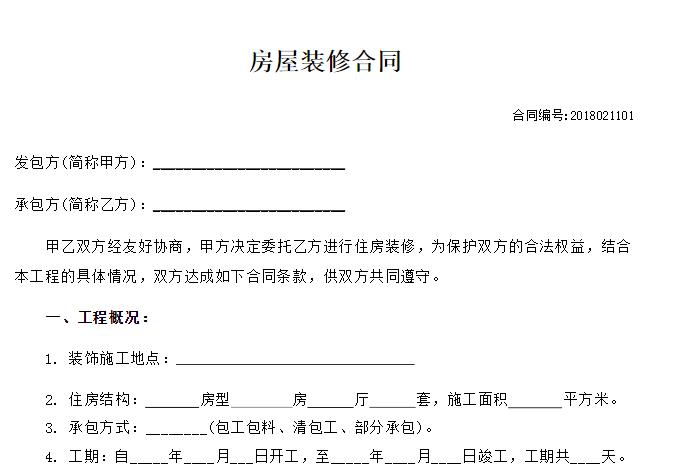装修设计合同范本免费下载
- 科普
- 2024-05-15
- 813
Title: Guide to Interior Design and Project Management Contracts
In the realm of interior design and project management, contracts serve as the foundation for successful collaborations between clients, designers, and contractors. Let's delve into the key components of a comprehensive contract tailored for the interior design and project management industry.
1. Introduction and Parties Involved:
Clearly identify the parties entering into the contract: the client, interior designer, and project manager (if applicable).
Provide contact information and addresses for each party.
State the effective date and duration of the contract.
2. Scope of Work:
Define the specific services to be provided by the interior designer and/or project manager.
Detail the project objectives, including design concepts, space planning, material selection, and project oversight.
Specify any limitations or exclusions to the services provided.
3. Project Timeline:
Establish a detailed timeline outlining key milestones, such as design concept approval, procurement of materials, and project completion.
Include provisions for potential delays and procedures for addressing them.
4. Fees and Payment Schedule:
Clearly outline the fee structure, including design fees, project management fees, and any additional charges.
Specify the payment schedule, including initial deposits, progress payments, and final payments upon project completion.
Address any circumstances that may result in additional fees or adjustments to the payment schedule.
5. Responsibilities of Each Party:
Define the responsibilities of the client, interior designer, and project manager throughout the duration of the project.
Clarify communication channels and procedures for resolving disputes or issues that may arise during the project.
6. Design and Material Selection:

Specify the process for design development, including client approvals and revisions.
Outline the procedure for selecting materials, finishes, and furnishings, including procurement and delivery logistics.
Address any warranties or guarantees provided for materials and products used in the project.
7. Project Management and Oversight:
Detail the project management services to be provided, including scheduling, budget management, and coordination of contractors and vendors.
Specify the level of oversight and supervision provided by the project manager throughout the construction or installation phase.
8. Changes and Amendments:
Establish procedures for requesting changes or amendments to the contract, including revisions to the scope of work or project timeline.
Address how changes will be documented and any associated fees or adjustments to the contract terms.
9. Termination and Dispute Resolution:
Define the circumstances under which either party may terminate the contract and the procedures for doing so.
Outline dispute resolution procedures, such as mediation or arbitration, to resolve conflicts that may arise during the project.
10. Legal and Regulatory Compliance:
Ensure compliance with all relevant laws, regulations, and building codes governing interior design and construction projects.
Include provisions for obtaining necessary permits and approvals required for the project.
11. Confidentiality and Intellectual Property:
Protect sensitive information and proprietary design concepts by including confidentiality clauses.
Specify ownership rights of design concepts, drawings, and other intellectual property developed during the project.
12. Insurance and Liability:
Require the interior designer and project manager to maintain appropriate insurance coverage, including professional liability insurance.
Clarify each party's liability for damages or losses resulting from their actions or negligence.
13. Governing Law and Jurisdiction:
Specify the governing law under which the contract will be interpreted and enforced.
Designate the jurisdiction or venue for resolving any legal disputes that may arise from the contract.
14. Signatures and Execution:
Provide space for signatures from all parties involved, along with the date of execution.
Ensure that each party retains a copy of the signed contract for their records.
By incorporating these essential elements into an interior design and project management contract, all parties can mitigate risks, clarify expectations, and foster successful collaborations. It's advisable to consult with legal professionals specializing in contract law to ensure that the contract meets the specific needs and requirements of the project.
上一篇
瑶海房产局电话
下一篇
个人装修名片设计图片